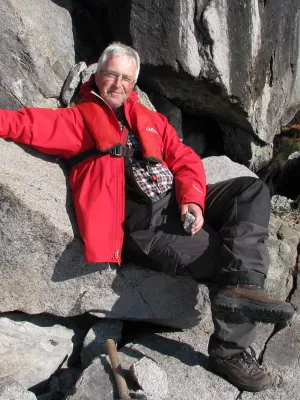
Leif Johansson
Professor emeritus

Zircon geochronology of migmatite gneisses along the Mylonite Zone (S Sweden): a major Sveconorwegian terrane boundary in the Baltic Shield
Author
Summary, in English
The southern section of the Mylonite Zone (MZ) is a major lithotectonic terrane boundary in the SW Baltic Shield. It separates the parautochthonous Eastern Segment of the Sveconorwegian orogen from the allochthonous Western Segment. Complex zircons in migmatised and banded orthogneisses along the southern MZ were investigated by ion microprobe analyses guided by backscattered electron imaging to directly date the partial melting and associated penetrative ductile deformation in this zone. In the eastern part of the MZ (Eastern Segment), resorbed igneous zircon cores in stromatic orthogneiss are 1686 +/- 11 Ma old, whereas extensive overgrowths and abundant newly formed simple zircons are 969 +/- 13 Ma old. Migmatised K-feldspar megacrystic granite has 1359 +/- 26 Ma igneous protolith zircon cores and abundant 968 +/- 13 Ma overgrowths and simple grains. Both rock units contain amphibolitised mafic pods with remnants of garnet-clinopyroxene-bearing, high-pressure granulite facies parageneses. In the western part of the MZ (Western Segment), igneous protolith zircon cores in stromatic orthogneiss, are dated at 1585 +/- 11 Ma and abundant new growth of zircon at 980 +/- 13 Ma. Enclosed mafic rocks have middle amphibolite facies parageneses. Secondary zircon in all three samples occurs as distinct, sub-idiomorphic overgrowths or as simple crystals with low Th/U ratios ( < 0.07). The morphology and high modal abundance of secondary zircon (25-50% of the total volume of zircon), the absence of early- or pre-Sveconorwegian secondary zircon, and field relations provide evidence for that anatexis and associated penetrative ductile deformation in the southern MZ took place between 980 +/- 13 and 968 +/- 13 Ma. These late-Sveconorwegian ages contradict previous interpretations of a pre-1.55 Ga age for the principal penetrative ductile deformation and stromatic layering of orthogneisses along the southern MZ. As a consequence, the role of the MZ as an important amalgamation zone for crustal growth in the Baltic Shield during the 1.70-1.55 Ga Gothian orogeny is questioned. Instead, the new data suggest that the MZ is a major Sveconorwegian lithologic and metamorphic terrane boundary along which middle-amphibolite facies supracrustals and orthogneisses of the Western Segment (protolith ages: 1.64-1.58 Ga) were juxtaposed against high-pressure granulite to upper-amphibolite facies orthogneisses of the Eastern Segment (protolith ages: 1.70-1.66 Ga) in late Sveconorwegian time. By implication, the pre-Sveconorwegian relation between crustal units west of the MZ and the margin of continent Baltica remains to be established. Understanding of the late Sveconorwegian tectonic evolution, particularly the amount of displacement along the MZ, is therefore, a pre-requisite for modelling the early and pre-Sveconorwegian tectonic evolution and crustal block configurations in the SW Baltic Shield.
Department/s
- Department of Geology
- Lithosphere and Biosphere Science
Publishing year
2002
Language
English
Pages
121-147
Publication/Series
Precambrian Research
Volume
114
Issue
1-2
Document type
Journal article
Publisher
Elsevier
Topic
- Geology
Keywords
- SW Sweden
- Sveconorwegian
- migmatite orthogneiss
- zircon
- Mylonite Zone
- ion microprobe
Status
Published
ISBN/ISSN/Other
- ISSN: 0301-9268

